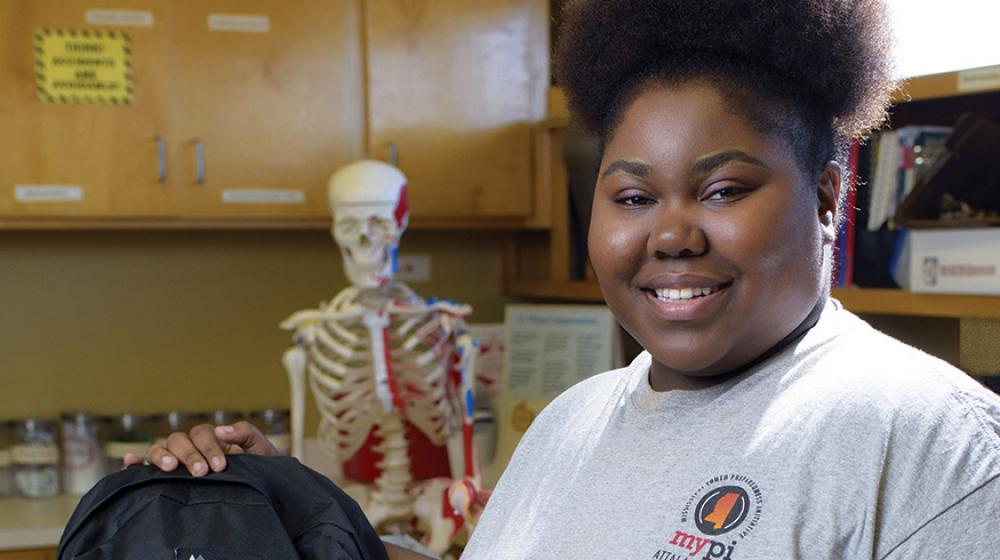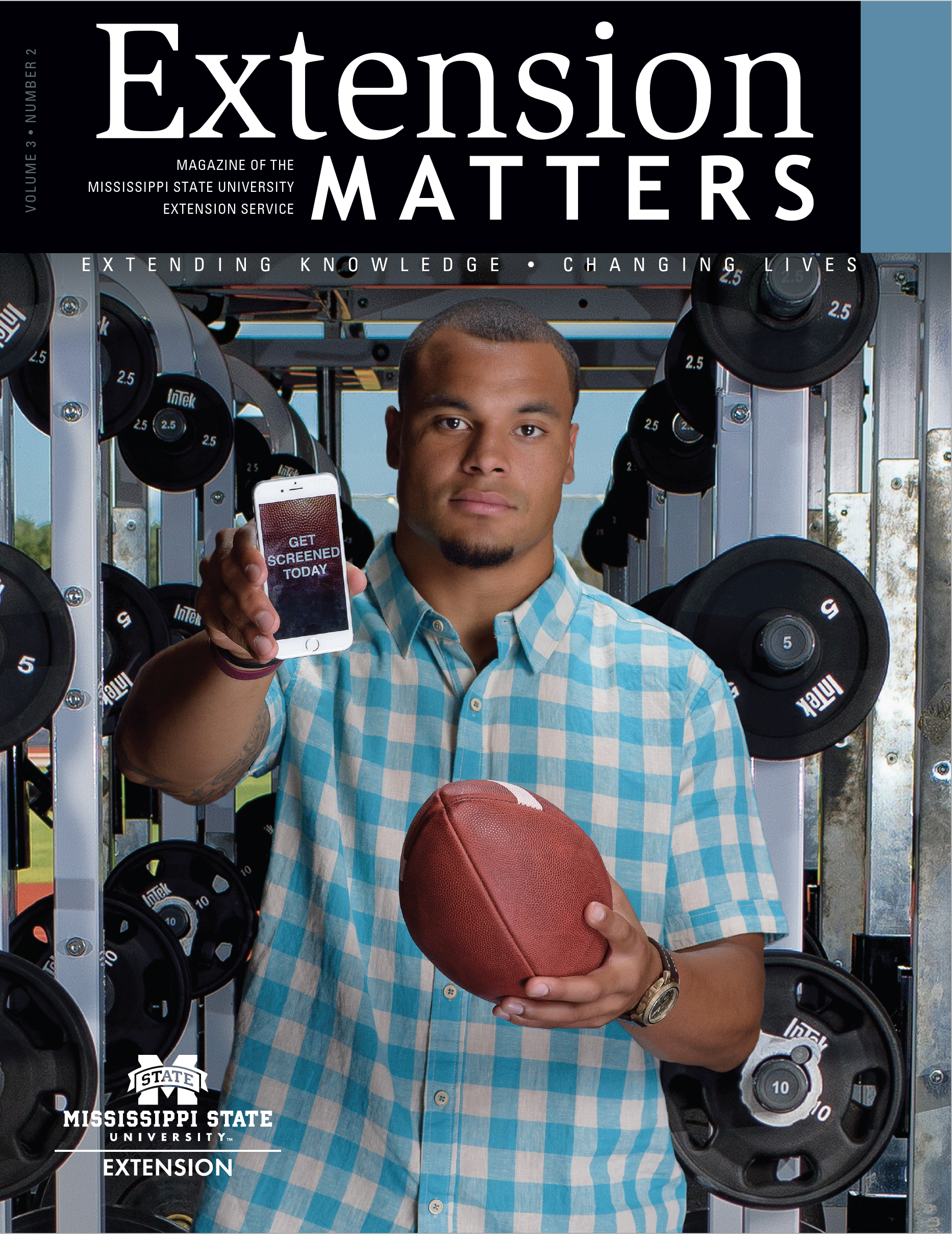Strengthening Communities

Shay Collins, MyPI participant
Teens learn emergency prep and leadership
Shay Collins and Kamrie Upchurch were not expecting to use the skills they gained in MyPI training just months after they learned them, but medical emergencies have never waited for anyone to be ready.
The two Ethel High School seniors were in a play rehearsal when a stagehand was putting items in an upstairs storage room.
“Her arm caught the sound box door, and it cut it from the top of the bicep to the bottom,” Collins remembers. “It looked just like a little scrape for a while until she shook her arm; then it just came loose. The first thing Kamrie and I thought about after we settled down was MyPI. We got our first aid kits out of our cars, wrapped her arm, and held it up for elevation.”
MyPI, or the Mississippi Youth Preparedness Initiative, is an educational youth outreach program that provides a dual focus on emergency preparedness and leadership opportunities for teenagers across the state. The Mississippi State University Extension Service leads the program with the Mississippi Citizen Corps, a unit within the Mississippi Office of Homeland Security.
With its comprehensive curriculum and capstone leadership project, the program allows students to develop hands-on experience in situations they might encounter if they were first responders.
In this case, the skills Collins and Upchurch learned helped them handle what could have been a serious injury to one of their classmates.
“The principal even told me how impressed he was with how the girls did,” says Amy Price, registered nurse and health science instructor at the Kosciusko- Attala Career Technical Center.
Dr. Ryan Akers, an assistant Extension professor specializing in community preparedness and disaster management, developed MyPI in 2011 with Dave Nichols, state program manager of Mississippi Citizen Corps.
“This program seeks to create a new standard for youth-preparedness education by having innovative and engaging programming that specifically targets our teens and brings them into preparedness discussions,” Akers says. “This effort is developed and directed by Extension, and we have made considerable progress in increasing our statewide footprint with the help of our Extension personnel and teachers across the state.”
Including Extension agents, the program has trained more than 200 MyPI instructors who teach in a variety of settings, including schools and vocational technical centers across the state.
The program has three primary components: the Federal Emergency Management Agency’s Community Emergency Response Team (CERT) curriculum; an add-on catalog of additional certifications and awareness programs, including CPR and defibrillator use, smoke alarm maintenance, HAM radio, NOAA weather radio, a career track, and a disaster simulation; and the Prep+6 capstone service project, which requires students to build emergency supply kits and family communication plans for their families and six other households.
Students meet with instructors two or three times a week for 5 to 10 weeks before graduating and receiving their MyPI diplomas and emergency response backpacks. With PowerPoint presentations and hands-on training in simulated emergency scenarios, sessions cover disaster preparedness, medical operations, fire safety, search and rescue, and other topics.
One way Attala County Extension agents Becky Hamilton and Taylor Casey teach students how to respond in emergencies is by having firefighters and doctors speak at some of the classes, so they can answer questions based on their experience. Hamilton was recognized as MyPI Instructor of the Year in 2016.
“Having first responders come in and talk to the students about their jobs helps them get a good idea of what goes into those professions,” Hamilton says. “It really opens their eyes to how important first responders are to our community.”
The Individual and Community Preparedness division of FEMA recognized MyPI with its Outstanding Youth Preparedness award in 2014, just one year after its full-scale implementation. In addition to expanding MyPI in Mississippi, through a federal grant opportunity, Akers now directs efforts with Extension personnel and emergency management officials in Tennessee, Virginia, New Jersey, Illinois, Nebraska, Washington, and Hawaii to replicate the MyPI model and develop sustainable youth preparedness programs around the country.
In response to increasing requests for similar programming for young people not yet old enough to participate in MyPI, Akers and Nichols developed Ready in the Middle, a pre-MyPI program delivered to 11- and 12-year-olds that focuses on risks, hazards in and around the home, and mitigation strategies.
Ready in the Middle bridges the gap between MyPI and a third youth preparedness program, the Pillowcase Project. Developed by the American Red Cross, this program caters to 8-, 9-, and 10-year-olds across the state. Extension agents have delivered the Pillowcase Project curriculum to nearly 3,000 children. All three programs combined make up what Akers refers to as the Youth Preparedness Continuum (YPC).
“One of my roles as an Extension faculty member in MSU’s School of Human Sciences is to develop high-quality, need-based programs that enhance individual, family, and community preparedness across the lifespan,” Akers says. “The YPC is unique in that all three programs are youth-centric, but all bring families in the fold.”
Casey believes programs like MyPI encourage many students to consider public service careers.
“The majority of students we teach have an interest in careers in the medical field, and I believe the MyPI program increases interest in the profession of first responders,” he says. “My favorite part about teaching this material is seeing that students have a genuine interest in disaster preparedness, as well as a desire to help others in a time of need.”
Collins is one of those students. After she graduates, she plans to volunteer with AmeriCorps—a nonprofit community service program—and enroll in medical school to become a pediatrician.
“I used to work in a daycare, and I have a little brother and cousins and nephews that are always at my house, so I love working with children, and I want to be in the medical field,” Collins says. “MyPI helped me realize that helping people in need is what I want to do and has prepared me and my classmates for whenever people are in need.”
While MyPI was developed to involve young people in emergency awareness planning, Akers says many students gain other skills during the program.
“With these programs, we have seen increased empowerment, self-esteem, communication, and family cohesion in our teenagers,” he says. “They feel like they belong to something bigger than themselves and are developing leadership skills, teamwork skills, and civic responsibility along the way.”

